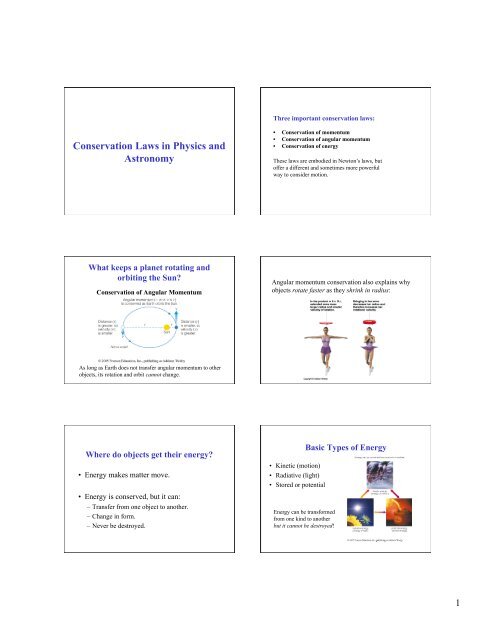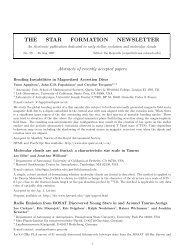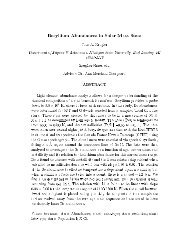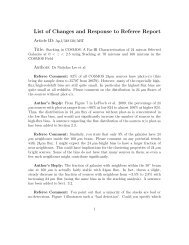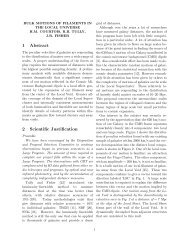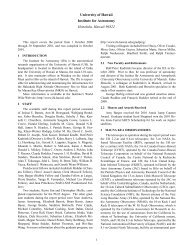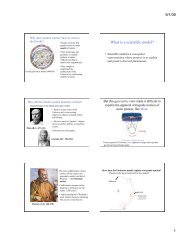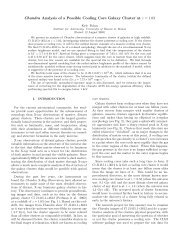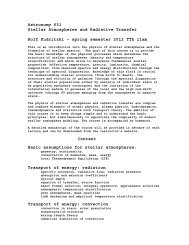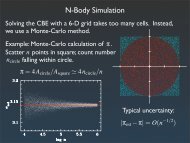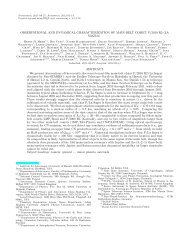3.7MB PDF File
3.7MB PDF File
3.7MB PDF File
Create successful ePaper yourself
Turn your PDF publications into a flip-book with our unique Google optimized e-Paper software.
Three important conservation laws:<br />
Conservation Laws in Physics and<br />
Astronomy<br />
• Conservation of momentum<br />
• Conservation of angular momentum<br />
• Conservation of energy<br />
These laws are embodied in Newton’s laws, but<br />
offer a different and sometimes more powerful<br />
way to consider motion.<br />
What keeps a planet rotating and<br />
orbiting the Sun?<br />
Conservation of Angular Momentum<br />
Angular momentum conservation also explains why<br />
objects rotate faster as they shrink in radius:<br />
As long as Earth does not transfer angular momentum to other<br />
objects, its rotation and orbit cannot change.<br />
Where do objects get their energy?<br />
• Energy makes matter move.<br />
• Energy is conserved, but it can:<br />
– Transfer from one object to another.<br />
– Change in form.<br />
– Never be destroyed.<br />
• Kinetic (motion)<br />
• Radiative (light)<br />
• Stored or potential<br />
Energy can be transformed<br />
from one kind to another<br />
but it cannot be destroyed!<br />
Basic Types of Energy<br />
1
Thermal Energy:<br />
This is the collective kinetic energy of many particles<br />
(for example, in a rock, in air, in water)<br />
Temperature Scales<br />
Thermal energy is related to Temperature but it is not<br />
the same.<br />
Temperature is the average kinetic energy of the many<br />
particles in a substance.<br />
Thermal energy is a measure of the total kinetic energy of all<br />
the particles in a substance. It therefore depends both on<br />
temperature and density.<br />
Example: boiling water versus hot air in oven.<br />
Mass-Energy<br />
Einstein showed that mass itself is a form of<br />
potential energy<br />
• A small amount of mass can release<br />
a great deal of energy (H-bomb,<br />
nuclear fusion in stars, etc.)<br />
• Concentrated energy can<br />
spontaneously turn into particles (for<br />
example, in particle accelerators)<br />
Gravitational Potential Energy<br />
• On Earth, depends on:<br />
– object’s mass (m)<br />
– strength of gravity (g)<br />
– distance object could<br />
potentially fall<br />
Gravitational Potential Energy<br />
• In space, an object or gas cloud has more gravitational<br />
energy when it is spread out than when it contracts.<br />
⇒ A contracting cloud converts gravitational potential<br />
energy into thermal energy.<br />
2
Newton’s Law of Gravity<br />
What determines the strength of gravity?<br />
The Universal Law of Gravitation states:<br />
1. Every mass attracts every other mass.<br />
2. Force of attraction is directly proportional to the<br />
product of their masses.<br />
3. Force of attraction is inversely proportional to the<br />
square of the distance between their centers.<br />
How does Newton’s law of gravity extend<br />
Kepler’s laws?<br />
Newton extended Kepler’s first two laws to<br />
apply to all orbiting objects, not just planets.<br />
• Using his laws of motion and<br />
gravitation, Newton demonstrated<br />
that ellipses are not the only<br />
orbital paths. Generally, orbits<br />
can be:<br />
– bound (ellipses and circles)<br />
– unbound<br />
• parabola<br />
• hyperbola<br />
Newton generalized Kepler’s Third Law<br />
Newton’s version of Kepler’s Third Law:<br />
IF a small object orbits a larger one and you measure the<br />
orbiting object’s orbital period AND average orbital distance<br />
THEN you can calculate the mass of the larger object.<br />
Examples:<br />
• Calculate mass of Sun from Earth’s orbital period (1 year) and<br />
average distance (1 AU).<br />
• Calculate mass of Earth from orbital period and distance of a<br />
satellite.<br />
• Calculate mass of Jupiter from orbital period and distance of<br />
one of its moons.<br />
Newton’s version of Kepler’s Third Law<br />
€<br />
p2= 4π2<br />
G(M 1<br />
+M 2<br />
) a 3<br />
p = orbital period<br />
a = average orbital distance (between centers)<br />
(M 1 + M 2 ) = sum of object masses<br />
How do gravity and energy together<br />
explain orbits?<br />
• Orbits cannot change spontaneously.<br />
• An object’s orbit can only change if it somehow gains or<br />
loses orbital energy =<br />
kinetic energy + gravitational potential energy<br />
(due to orbit).<br />
3
• If an object gains enough orbital energy, it may<br />
escape (change from a bound to unbound orbit)<br />
⇒ So what can make an object gain or lose orbital<br />
energy?<br />
• Friction or atmospheric drag.<br />
• A gravitational encounter.<br />
• escape velocity from Earth ≈ 11 km/s from sea<br />
level (about 40,000 km/hr)<br />
How does gravity cause tides?<br />
Escape Velocity<br />
Definition: The minimum velocity that a body must<br />
attain to escape a gravitational field completely.<br />
• A cannonball fired horizontally at 8<br />
km/s from Newton’s mountain would<br />
find itself in circular orbit around<br />
the Earth (case D).<br />
• At greater starting speed, but less<br />
than 11.2 km/s, it will take an<br />
elliptical orbit and return in a<br />
slightly longer time (cases E and F).<br />
• When tossed at a critical speed of<br />
11.2 km/s, the cannonball leaves<br />
the Earth and never returns.<br />
• Tossed at more than 42.5 km/s, it<br />
will escape the solar system.<br />
Special Topic: Why does the Moon always show the<br />
same face to the Earth?<br />
Tides vary with<br />
the phase of the<br />
Moon!<br />
Moon rotates in the same amount of time that it orbits the<br />
Earth, but why?<br />
4
This is because of tidal friction!<br />
Summary<br />
• What determines the strength of gravity?<br />
• Directly proportional to the product of the masses (M x m)<br />
• Inversely proportional to the square of the separation d<br />
• Tidal friction gradually slows Earth’s rotation (and makes Moon get farther<br />
from Earth).<br />
• Moon once orbited faster (or slower); tidal friction caused it to “lock” in<br />
synchronous rotation.<br />
• How does Newton’s law of<br />
gravity allow us to extend<br />
Kepler’s laws?<br />
• Applies to other objects, not<br />
just planets.<br />
• Includes unbound orbit<br />
shapes: parabola, hyperbola<br />
• We can now measure the<br />
mass of other systems.<br />
• How do gravity and energy<br />
together allow us to<br />
understand orbits?<br />
• Gravity determines orbits<br />
• Orbiting object cannot<br />
change orbit without<br />
energy transfer<br />
• Enough energy -> escape<br />
velocity -> object leaves.<br />
Summary (Cont.)<br />
• How does gravity cause tides?<br />
• Gravity stretches Earth along Earth-Moon line because<br />
the near side is pulled harder than the far side.<br />
Energy Conservation in Orbital Motion<br />
• Everywhere on its orbit, a satellite has both kinetic energy (KE) and potential energy<br />
(PE)<br />
• The sum of KE and PE is a constant all through the orbit.<br />
• In a circular orbit, the distance between the satellite and the attracting body is always<br />
the same, meaning that PE and KE of the satellite are the same everywhere.<br />
• In an elliptical orbit, both the distance and speed of the satellite vary, therefore PE and<br />
KE must change. However, KE+PE is always the same at every point of the orbit.<br />
A<br />
F<br />
S<br />
P<br />
• PE is greatest (KE is least) when the satellite is farthest away from<br />
the attracting body (at A).<br />
• PE is least (KE is greatest) when the satellite is closest to the<br />
attracting body (at P).<br />
• Except at A and P, there is a component of the gravitational force<br />
parallel to the direction of orbital motion (see sketch).<br />
• Planet gains altitude (PE increases) when it moves against this<br />
component of the force, and its speed and KE decrease (at point S).<br />
• Planet loses altitude (PE decreases) when it moves in the direction of<br />
this component of the force, and its speed and KE increase (at point F).<br />
5


